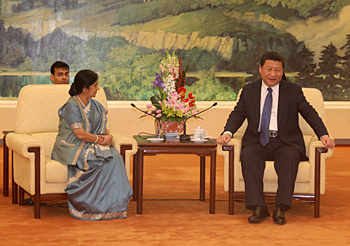INDIAN ARMED FORCES CHIEFS ON OUR RELENTLESS AND FOCUSED PUBLISHING EFFORTS

SP Guide Publications puts forth a well compiled articulation of issues, pursuits and accomplishments of the Indian Army, over the years

"Over the past 60 years, the growth of SP Guide Publications has mirrored the rising stature of Indian Navy. Its well-researched and informative magazines on Defence and Aerospace sector have served to shape an educated opinion of our military personnel, policy makers and the public alike. I wish SP's Publication team continued success, fair winds and following seas in all future endeavour!"

Since, its inception in 1964, SP Guide Publications has consistently demonstrated commitment to high-quality journalism in the aerospace and defence sectors, earning a well-deserved reputation as Asia's largest media house in this domain. I wish SP Guide Publications continued success in its pursuit of excellence.
Sino-Indian Relations new horizons
 |
By Lt. General P.C. Katoch (Retd) Former Director General of Information Systems, Indian Army |
It is but typical of China to shroud her intent in a cloak of ambiguity. Take three recent events: first, successful visit by External Affairs Minister to Sushma Swaraj to China; second, Indian Army and PLA troops ceremonial meet at Chushul on 18 February on occasion of the Chinese Spring festival with both sides vowing to maintain peace and tranquility along the Line of Actual Control (LAC), and China’s Foreign Ministry protesting vehemently against Prime Minister Modi’s visit to Arunachal Pradesh. But going by media reports, External Affairs Minister Sushma Swaraj was the first ever foreign minister from any country to have been met by President Xi Jinping during her recent four day trip to Beijing including to attend the 13th Russia-India-China (RIC) Foreign Minister’s Meeting. This gesture of President Xi itself set aside speculations that China had apprehensions about what went on between Prime Minister Modi and President Obama during the latter’s recent visit to New Delhi.
 Sushma Swaraj External Affairs Minister calling on President Xi Jinping of People's Republic of China in Beijing.
Sushma Swaraj External Affairs Minister calling on President Xi Jinping of People's Republic of China in Beijing.The hallmark of the 13th Russia-India-China Foreign Minister’s Meeting was both China and Russia agreeing to back the Comprehensive Convention on International Terrorism (CCIT) which India had proposed to the United Nations in 1996, which aims directly at rogue countries like Pakistan. The support has come with regions of Xinjiang and Chechnya wracked by increasing terrorism. A joint communiqué issued after the summit “underlined the need to bring to justice perpetrators, organizers, financiers and sponsors of terror acts.” The RIC communiqué vouched to oppose terrorism of all forms and called on all countries to join efforts in combating terrorism together with the UN. Our EAM has stated that her counterparts from the two countries (China and Russia) understood the need for endorsing the CCIT that has been pending at the UN for nearly two decades and seeks to widen the existing definition of terrorism. Other focus areas mentioned by the EAM at the joint press interaction post the RIC meet were: Russia and China have reiterated support for India’s aspiration for a greater role in the UN; Chinese and Russian support to India’s SCO membership after legal and procedural formalities are over; fellow counterparts in BRICS welcoming India’s participation in Asia-Pacific Economic Forum (APEC); continued new direction mutually for economic growth at regional and International level and improving administration of financial economies, and; asset management and cooperation for better economic coordination. Prime Minister Narendra Modi is scheduled to visit China in May including travelling for the Mansarovar Yatra via Nathu La. If the manner in which PM Modi handled President Obma to alleviate Indo-US relations, he is likely to deal with the Sino-Indian relations similarly, opening new horizons. The Indo-US Nuclear Deal was successfully inked after lying in limbo for years. It would be remarkable if both leaders can come to a mutually agreeable political solution to the vexed border problem. President Xi has emerged far more powerful than his predecessors, breaking the yokel of consensus politics in China, amongst other actions also going all out against corruption within the highest echelons; already more than 1,82,000 officials across numerous regions and at all levels of government have undergone probes, with top military officials and even a former member of all powerful and hitherto ‘untouchable’ Politburo Standing Committee, China's highest governing body deposed. In India the first signs of purging top level corrupt bureaucrats and corrupt politicians have emerged. The bottom-line is that both PM Modi and President Xi are strong leaders possessing geostrategic vision plus dedication and commitment to bring greater peace and prosperity to the populations of their countries and the region. Being leaders of the two most populous countries in the world, they can mutually transform the destiny of Asia by arriving at common approach to the dynamic geopolitics at the regional and global level. While progressing the RIC Dialogue is a sure catalyst, the two leaders perhaps could focus on following issues during the forthcoming visit of Prime Minister Narendra Modi to China coming May: define outline of political solution to the boundary issue with timetable of its execution; establishment of Russia-China-India north-south economic, energy and transportation corridors; stake goalposts for mutual cooperation for security, stability and reconstruction of Afghanistan; enhancing mutual economic cooperation and Chinese investments in infrastructure development in India; possible technology cooperation in agriculture, rain making, flood control, extraction of shale gas, reducing carbon-dioxide emissions, and; taking the CCIT to its logical conclusion at the UN and its enforcement. It is well understood that China will remain focused on the China-Pakistan economic corridor. But the Russia-China-India economic, energy and transportation corridors will be much beneficial to the three countries, as well as the region. Such measures will open new horizons in the Sino-Indian bilateral relationship.





